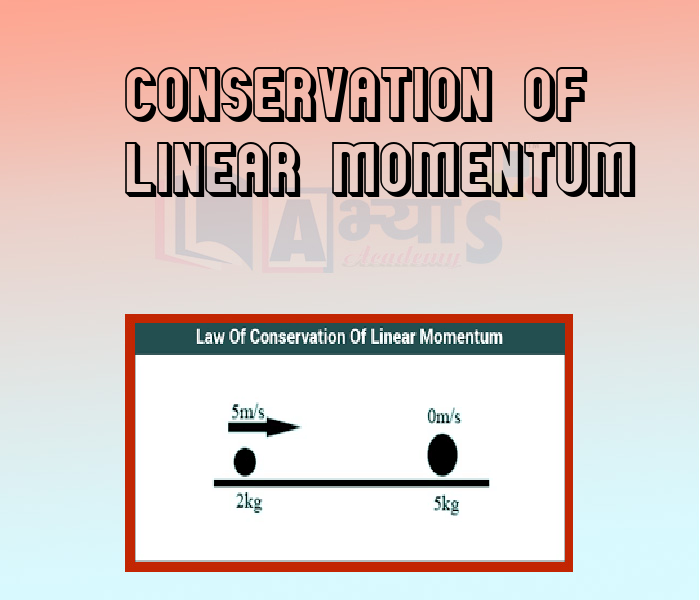Conservation of Linear Momentum











Conservation of Linear Momentum
The linear momentum which is the product of mass and velocity also remains constant if the total force acting on it is zero. Consider two particles A and B. We can call the group of these two particles as System of Particles. The force exerted by A on B and exerted by B on A are called Internal Forces. Force applied on A or B by any external particle is called External Forces.We define the total linear momentum of the system as sum of linear momenta of A and B.If the two particles moving along the same straight same line, the momentum of the system is arithematic sum of their momenta, i.e. , where
,
are the masses of the particles and
are their velocities.
Examples of law of conservation of linear momentum:
1. Bomb shell explosion: A bomb shell suddenly explodes in two fragments having masses in the ratio 2 : 1. As there is no external force involved in the process of explosion the momentum of the system should be conserved.In this case the bomb is initially at rest the initial momentum of the system is zero. The conservation of momentum demands that the final momentum should also be zero. The two fragments should carry equal and opposite momentum to make total momentum zero.
2. Recoil of the gun: As the initial momentum before the firing of bullet is zero .So according to the conservation of momentum the final momentum of the system also needs to be zero.The final momentum could be zero only if the gun has a momentum equal and opposite to that of the bullet.
3. Jet engines and Rockets: A rocket at the launching pad has zero momentum.When the chemicals inside the rocket burn a high velocity blast of hot gases is produced.Thses gaes pass out the tail nozzle of the rocket in downward direction on the form of the jet with tremendous velocity.Therefore the rocket moves up with such a velocity so as to make the momentum of the system(rocket +emited gas) zero again.
Two balls of mass 20 Kg and 30 kg are moving with speed 5 m/s in opposite directions towards each other and collide. What will be the mangnitude of total momentum of the system before the collision? | |||
| Right Option : A | |||
| View Explanation | |||
A bullet of mass 0.01 kg is fired from a gun weighing 5.0 kg. If the initial speed of the bullet is 250 m/s, calculate the speed with which the gun recoils. | |||
| Right Option : A | |||
| View Explanation | |||
Two balls of mass 20 kg and 30 kg are moving with speed 5 m/s and 10 m/s in opposite directions towards each other and collide. What will be the magnitude of total momentum of the system before the collision ? | |||
| Right Option : A | |||
| View Explanation | |||
Students / Parents Reviews [10]
Abhyas Methodology is very good. It is based on according to student and each child manages accordingly to its properly. Methodology has improved the abilities of students to shine them in future.

Manish Kumar
10thMy experience was very good with Abhyas academy. I am studying here from 6th class and I am satisfied by its results in my life. I improved a lot here ahead of school syllabus.

Ayan Ghosh
8thAbout Abhyas metholodology the teachers are very nice and hardworking toward students.The Centre Head Mrs Anu Sethi is also a brilliant teacher.Abhyas has taught me how to overcome problems and has always taken my doubts and suppoeted me.

Shreya Shrivastava
8thA marvelous experience with Abhyas. I am glad to share that my ward has achieved more than enough at the Ambala ABHYAS centre. Years have passed on and more and more he has gained. May the centre flourish and develop day by day by the grace of God.

Archit Segal
7thAbhyas is a complete education Institute. Here extreme care is taken by teacher with the help of regular exam. Extra classes also conducted by the institute, if the student is weak.

Om Umang
10thOne of the best institutes to develope a child interest in studies.Provides SST and English knowledge also unlike other institutes. Teachers are co operative and friendly online tests andPPT develope practical knowledge also.

Aman Kumar Shrivastava
10thMy experience with Abhyas is very good. I have learnt many things here like vedic maths and reasoning also. Teachers here first take our doubts and then there are assignments to verify our weak points.

Shivam Rana
7thMy experience with Abhyas academy is very good. I did not think that my every subject coming here will be so strong. The main thing is that the online tests had made me learn here more things.

Hiya Gupta
8thI have spent a wonderful time in Abhyas academy. It has made my reasoning more apt, English more stronger and Maths an interesting subject for me. It has given me a habbit of self studying

Yatharthi Sharma
10thIt has a great methodology. Students here can get analysis to their test quickly.We can learn easily through PPTs and the testing methods are good. We know that where we have to practice
